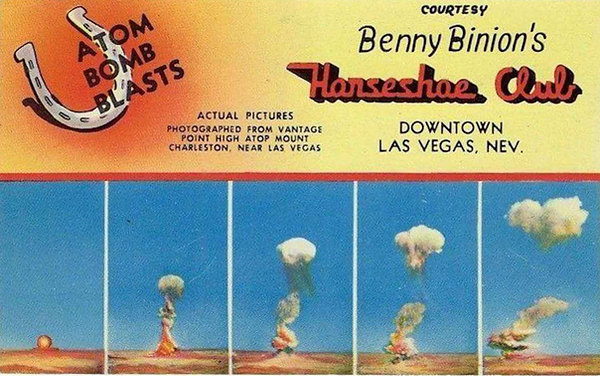When it was first announced that nuclear testing would be happening in such close proximity to Las Vegas, several concerns were raised not least of which was the worry that the fear of atomic explosions would chase away the tourists.
Of course Vegas being Vegas, the exact OPPOSITE happened. In fact, immediately after the first bomb was detonated, the Las Vegas Chamber of Commerce issued a stream of press releases describing the new testing grounds as one of the many "unique attractions" Las Vegas had to offer.

Hotel guests at the Last Frontier Hotel poolside watching a mushroom cloud, 1953
Photo Credit: Las Vegas Review-Journal
The atomic tests that happened during the "Ranger" series accounted for one of the biggest influxes of tourists the city had ever seen. Following the "Baker" shot (the second test conducted) Vegas residents were setting their alarms so they could be out watching the 5:45am detonations and cars packed with spectators would begin lining the roads around the test site at the best vantage points.
The Atomic Tourism Industry was born.
It became even bigger on April 22, 1952 when 200 reporters and camera-men from across the nation gathered together on a mound of rock at the edge of Yucca Lake that would later become known as "News Knob". They were there at the invite of the US Government to record and broadcast - for the first time ever - the test of a 31 kiloton nuclear bomb dubbed "The Big Shot".

Reporters & camera-men gather at "News Knob" near the Nevada Test Site on April 22, 1952
Photo Credit: United States Army
From just ten miles away, the American public were given the opportunity to witness - from the safety of their livingrooms - the raw power of a nuclear explosion.

The view from "News Knob", Yucca Flat, Nevada. 1953
Photo Credit: United States Army
After the televised test, "atomic culture" swept the nation with Las Vegas at the center of it all.
The Las Vegas Chamber of Commerce printed up calendars advertising detonation times & testing dates months in advance; tourism officials posted guides with the best places to view the tests; downtown casinos began hosting "Dawn Bomb Parties" on their rooftops; and tour companies sold "Up and Atom" packages where guests would be driven out to "a safe distance" from Ground Zero to observe the tests.

Mushroom Clouds, the iconic symbol of the nuclear tests, began showing up everywhere including billboard, merchandise, hairstyles and costumes. A specialty drink, "The Atomic Cocktail" (made with vodka, cognac and champagne served over ice) found its way to casino & hotel bars.
Legendary casino owner Benny Binion was once quoted as saying, "The best thing to happen to Vegas was the Atomic Bomb!"

The atomic craze even led to one of the most bizarre combinations of all time, and one that could really only ever happen in Las Vegas: Nuclear Bombs & Showgirls!
On May 9, 1952, Las Vegas dancer Candyce King became the first ever "atomic pin-up girl" with her photo appearing in the "Dixon Evening Telegraph" and "Statesville Daily Record" newspapers and in early May 1955, an unidentified Copa Girl from The Sands Hotel was crowned "Miss Cue" by soldiers involved in "Operation Cue".
And on May 24, 1957, the Las Vegas News Bureau released a photo of the last - and possibly the most famous - "Miss Atomic Bomb" of all time: Sands Copa Girl, Lee A. Merlin. The photo was taken by Las Vegas Sun photographer Don English featured Ms. Merlin standing in the desert wearing a cotton mushroom cloud on the front of her swimsuit. The picture was distributed nationally and to this day, it appears all over the world in publications & pop culture.

L-R: Candyce King, the first "atomic pin-up"; unidentified Sands Copa girl crowned "Miss Cue"; Lee A. Merlin, "Miss Atomic Bomb" photographed by Don English
But as the saying goes, "all good things must come to an end."
By the time the last atmospheric explosions were happening at the Nevada Test Site, nuclear testing was no longer the great tourist attraction that it once had been. Testing had become routine and people were no longer excited by it.
Then, on August 5, 1963, the US and the Soviet Union signed the "Limited Test Ban Treaty" which prohibited nuclear tests in the atmosphere, underwater or in space which drove nuclear testing underground - literally - and putting the final nail in the coffin for the Atomic Tourism industry.






